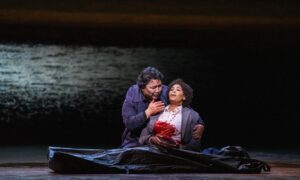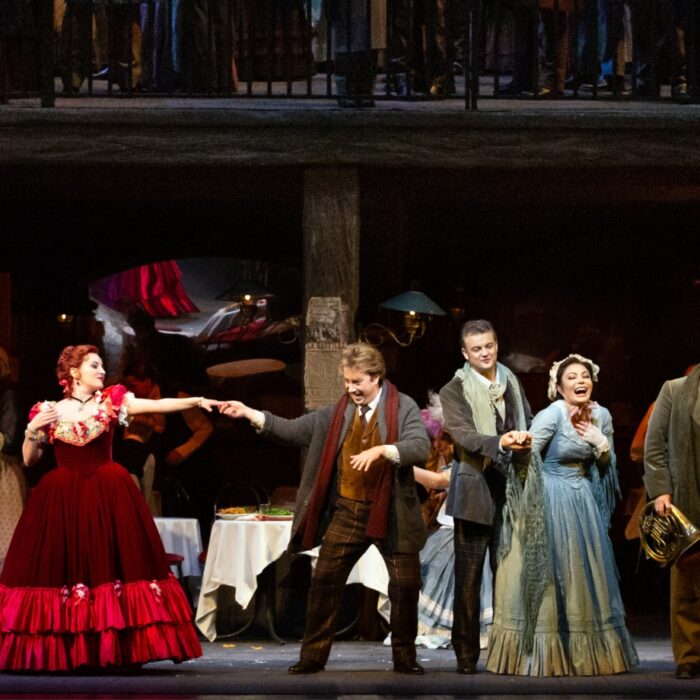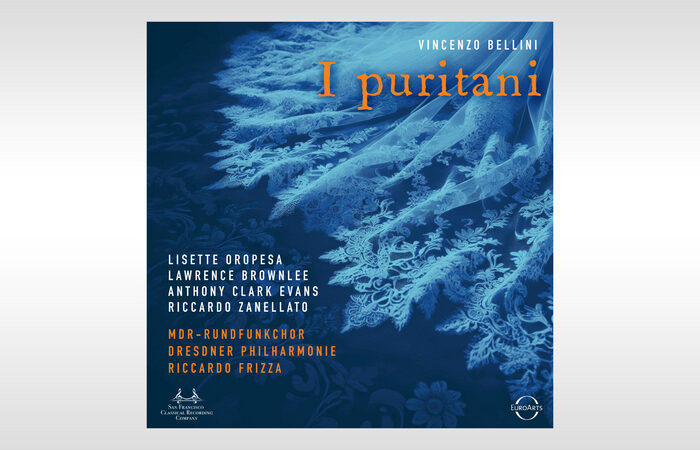
Royal Opera House 2023-24 Review: Rigoletto
Amartuvshin Enkhbat & Pretty Yende Shine in Verdi Masterpiece
By Mauricio Villa(©Tristram Kenton)
The Royal Opera presented at their Covent Garden Theatre a revival of their new production of “Rigoletto” by the stage director, and artistic director of the Royal Opera, Oliver Mears.
Oliver Mears’ production is austere and minimalistic. The first two acts have a back golden wall, with big paintings hanging on the palace’s scenes, and Gilda’s room for the final scene of the first act, creating big empty spaces. The wall moves away to one side for the final scene where there is a backdrop with the water of the river and the sky. It’s simple, but somehow is meaningless. It doesn’t add anything new to the story or the narrative of the opera. I am not sure if the violent reaction of the Duque of Mantua at the end of the first scene by ripping out Monterone’s eyes, which might have reminded one a bit too much of Shakespeare’s King Lear, works as the aggressiveness of the character doesn’t develop in the next acts. So, it is an isolated action not connected at all with the rest of the opera.
The performances were believable and truthful, but followed sometimes “old clichés” like Rigoletto singing his second act aria on his knees. The choreography of the choir: “scorrendo uniti…” did not work as it seemed ridiculous that a choir which has been mostly static, suddenly does some kind of cabaret movements. One can fully comprehend the story and follow the plot, as Mears staged the opera being respectful to the music and the libretto. It was a beautiful effect to have real water pouring down during the storm that takes place in. the third act.
A Great Rigoletto
From the very first line, “in test ache avete,” it was clear that Amartuvshin Enkhbat was going to be a great Rigoletto, with his strong dark instrument and ability to color the voice. But, much more is needed than a big dark voice to sing Rigoletto. The role demands long legato singing. In his two duets with Gilda and the slow section of his second act aria, in a high tessitura and the ability to color the voice to vocally portray the multiple psychological layers of this complex character. Enkhabt sounded cynical, comical, and even aggressive during “Chi’o gli parli.” But his first. “Quel Vecchio maledivami” was sung in a mysterious mezza voce with a slight diminuendo from mezzo forte to pianissimo. He delivered another whispering pianissimo in “E dove all occassione.”
He sang his first act aria “Parisiamo” with a continuous contrast between rage and sorrow, sadness and happiness, regret and thankfulness, making a wise use of his mezza voce and pianissimi in contrast to strong secure passages. Once more he used his mezza voce for “Mi cogliera sventura” and then drastically changed to a strong aggressive sound for his final line with a high G, “…è follia.” Enkhabt showed his expansive legato singing in his first duet with Gilda, where he has to sing long fluid lines in a high tessitura, and his ability to sing diminuendo up to high Fs (an uncomfortable zone for a baritone.) He culminated the first act with a strong and dramatic “Ah! La maledizione.”
But his interpretation developed and increased nuances in the second act, being ironic and dolent in “La rá, la rá…” and drawing the big dramatic arch of his aria ”Cortiggiani!,” where Rigoletto goes from fury and anger, begging for pity and forgiveness. He once more delivered secure high G’s and F-sharps and sang legato with dynamics during the slow section “miei signori, perdono…”. He was sweet and encouraging in his second act duet with Gilda, “Piangi, piangi,” but turned mad and full of rage for the final ”Vendetta!…” which he coronated with a strong and secure A-flat. The third act is much shorter for Rigoletto but he still has to sing all the traditional interpolated F-sharps in “All’onda!” He even kept his voice fresh after a long night of singing to deliver an astonishing A-natural in the final ”Maledizione!” Amartuvshin Enkhbat was an amazing Rigoletto, both vocally and dramatically.
Opposites Collide
Gilda was portrayed by the international opera star Pretty Yende. She began her career by singing lirico-leggera roles, but her voice has become more lyrical lately. She possess a velvety dark, big sound with a strong middle register up to high B-flat and then bright sparkling high notes up to E-flat.
She began the first act by portraying a naïve and innocent girl by lighting the sound of her voice, making it crystalline. She delivered a few effortless staccato B-flats. It was clear that the soprano was holding back her voice in order to vocally portray this young girl. She sang an amazing interpretation of her first act aria, “Caro nome,” which was a showcase of high notes (long sustained like the D-flat in “a te sempre volera”). She had agile staccato singing in, “a tè volerà” and her cadenza, where she sang the traditional staccato jumps between D-flats and B-naturals plus an E-flat. Her voice sounded agile and crystalline. Her coloratura was clean and precise.
But Yende changed drastically for the second act, presenting her full dark potent voice in. “Tutte le feste al tempio” and the subsequent duet with Rigoletto, delineating vocally and dramatically the radical change in Gilda as she has been betrayed and sexually abused by the Duque. She was strong and determined in “Vendetta,” culminating this frenzy duet with a sparkling long high E-flat. Her voice was clearly present in the quartet ”Bella figlia dell’amore.” She sang an unexpected long sustained high D at the end of the trio during the storm. And she sang her dying scene with a light sound and soaring B-flats in pianissimo.
Stefan Pop portrayed the violent womanizer Duque Of Mantua. This tenor has the tessitura for this role, which demands singing legato in the passagio zone, strong middle range and secure top register. But his timbre is uneven, it possesses an ungrateful marked fast vibrato and the voice sounds unstable and weak. He has a modest projection, which was enough for this role which does not sing over heavy orchestration but mostly light orchestration. He has a tendency to open the sound widely in the middle to lower zone of the voice and in some high notes, covering and darkening only the passagio zone which makes dramatic changes in the timbre, the color and the projection of the voice.
He sang a light and easy entrance aria, “Questa o quella,” with the traditional added B-flat at the end, although the voice sounded like it was strangling in several A-flats and the B-flat for his tendency to open the sound. And that was his modus operandi throughout all his performance. He could sustain the high tessitura of his first act duet with Gilda, “È il sol dell’aniima,” easily singing bravely and with determination the line: “d’invidia agli uomini” which raises chromatically up to high B-flat. Although, he sang a strange portamento in “Che gl’angeli” to attack the A-natural, breaking the fluidity of the line. He used a beautiful mezza voce for the cadenza and last part of the duet.
He was solvent in his second act aria, “Ella mi fu rapita… Parmi veder le lagrime” and caballetta, “Possente amor mi chiama,” as well as in the third act’s famous aria “La donna è mobile” and subsequent quartet “Bella figlia dell’amore.” Although the final B-natural of the aria turned out to be too short. Pop is a good singer, and he makes the best use he can of his instrument, but the results were not always satisfactory.
More Cast Highlights
The Italian bass Gianluca Buratto sang the role of the assassin Sparafucile. He has a dark and deep sound, covered and round throughout his whole register. He demonstrated his voice control by singing “Sparafucile mi nomino” in an exquisite mezza voce, and his secure strong low register by holding his last low F till the very last bar of music, which provoked a spontaneous applause from the audience. He was aggressive in his short intervention in the third act with his voice well projected during the “storm scene” as his voice carried over the orchestra and soloist in forte easily. And he concluded his performance with another impressive low note, the low G-flat in “Buona notte.” Ramona Zaharia portrayed an amazing Magdalena who was presented in this production as a drug addict and alcoholic prostitute. In this short part she could show her vibrant middle and low register which is where the character is singing all the time. Her powerful voice was noticeable in the storm where she has to sing over the orchestra and other soloists in forte.
The British conductor Julia Jones was in charge of the Royal opera orchestra. She managed to build and keep great moments of tension like the dark overture, the duet between Sparafucile and Rigoletto, Rigoletto’s second act aria or the storm scene. At the same time, she created moments of great lyricism like the flute line that introduces Gilda’s character in Rigoletto’s first aria, the long-sustained Andante of the three duets between Gilda and Rigoletto or the Duque of Mantua’s second act aria. She found a perfect balance between the voices and the orchestra volume. Therefore, the fortissimos were dramatic, but they never hid the voices. The intervention of the Royal Opera Chorus was impressive. They sounded strong and powerful.
A simple production with detailed staging and a stelar cast of great voices paired with the magnificent work of the conductor Julia Jones.


